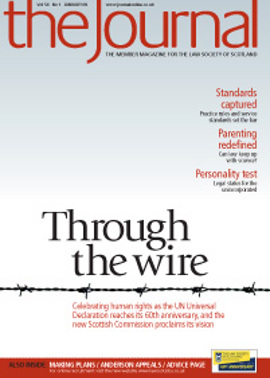Manual for the mind

Have you ever wondered what makes the difference between those who achieve excellent results in life and those who don’t, or those who are excellent communicators and those who are merely average? Have you ever done something so brilliantly that once you’d finished congratulating yourself, you wondered how you did it or, indeed, how you could do it again?
Neuro-linguistic programming (NLP) enables us to discover the difference between competence and excellence in any given area of human activity. By identifying and defining how our minds work, NLP shows us how to understand and model our own successes, enabling us to replicate them consistently. It allows us to understand and model the successes of other top achievers in any field, thus rapidly expanding our world of possibilities. It also helps us to understand the ingredients of less-than-helpful performances, in ourselves or in others, and how to remedy these.
What is NLP?
The name, although cumbersome, attempts to link succinctly three ideas: Neuro-, the use of mind and body and how they operate as a system; Linguistic, how we use language to order our thoughts and behaviour; and Programming, the use of sequences, programmes or patterns of behaviour and how once understood these can be reprogrammed. By developing a practical understanding of these processes we can learn how to achieve results that often seem magical.
Described variously as “the art and science of personal excellence”, “the study of subjective experience”, and “the psychology of achievement and interpersonal communication”, it’s essentially the study of how we organise, edit and filter the outside world through our senses, then describe it in language, both intentionally and unintentionally, to produce results. NLP can be applied to any human activity, and its tools and techniques are used internationally with huge success in business, education, personal development, sport, health and therapy.
Whilst it’s almost impossible to attend an advanced leadership or management training course that doesn’t consist largely of NLP patterns, its potential in law, whilst immense, has yet to be fully realised by the profession. It vastly improves mediation, negotiation and conflict resolution skills, facilitates more effective communication with clients, colleagues and opponents, and in advocacy its potential for influence is enormous.
Where is it from?
NLP is a model derived from cognitive and behavioural psychology created in 1975 by Richard Bandler and John Grinder, who began modelling and duplicating the “magical results” of a few top communicators and therapists such as world famous hypnotherapist Milton Erickson, Gestalt therapist Fritz Perls and family therapist Virginia Satir. By studying people who achieve excellence and how they behave, think and feel, it is possible to build up models of excellence for a wide range of skills and to teach others how to develop the most effective ways of thinking and communicating.
How does it work?
“If the doors of perception were cleansed, everything would appear to man as it is, infinity.” (William Blake)
Perceiving the world outwardly through our five senses: sight (visual), sound (auditory), touch (kinaesthetic), smell (olfactory) and taste (gustatory), we re-present the experience inwardly to ourselves, constructing a unique model or map of the world at an unconscious level. We then live in the model as though it is reality, but the map is not the territory. Most problems derive from the models in our heads rather than from the world as it really exists. Once we have a practical understanding of how these inner models work, we can learn to convert our unhelpful thoughts, feelings, habits and beliefs into more useful ones.
A large part of communicating successfully with others is the ability to notice what is really going on for them at a conscious and unconscious level, so that we better understand their “maps” of the world and can respond appropriately. We each use all of our available senses, but unconsciously tend to favour some over others. By carefully observing others’ eye and body movement, it is possible to determine whether they are more visual, auditory, kinaesthetic or auditory digital, and different body postures are associated with accessing different sensory processes and psychological states. Their choice of words (in person or in writing) also indicates their sensory preference.
Perceptual filters
Have you ever wondered why two people attending the same event have different responses? It’s because we each filter the information from the outside in different ways. Our senses are bombarded with 2,000,000 pieces of information per second, of which the brain can only process 134 and the conscious mind only seven (plus or minus two) chunks or manageable units of information per second. To prevent information overwhelm, we run it through our internal processing filters, which delete, distort and generalise the information to make an internal representation made up of pictures, sounds, feelings, taste and smell. We then label those experiences with our internal dialogue, which constitutes suggestions we give to the unconscious mind.
Deletion occurs when we selectively pay attention to certain aspects of our experience and ignore others; distortion when we make shifts in our experience of sensory data by misrepresenting reality (helpful in planning and creating imaginary futures); and generalisation when drawing global conclusions based on our experiences, which is helpful for learning, but less so when drawing broad conclusions about the world based on one or two experiences.
When communicating, we have a full idea of what we wish to say – the “deep structure”, which is not conscious. We shorten this deep structure – by deleting, distorting and generalising – and what we actually say is called the “surface structure”. The NLP meta model provides a series of questions designed to fill in the missing information, reshape the structure and elicit specific information to make sense of the communication. This process enables us to better understand other people’s internal maps.
Excellent advocates are highly effective at reconnecting witnesses to the deep structure of what they want – or don’t want – to communicate. In NLP terms, they also excel at reframing and employing ingenious “sleight of mouth” patterns, as do highly effective mediators and negotiators. NLP shows us how to learn these skills.
Metaprogrammes
One of the perceptual filters we habitually act on to create our unique experience of the world is our “metaprogrammes”. Some of the simplest include:
• Proactive-reactive. The proactive person initiates action. The reactive takes time to analyse and understand first, before acting.
• Towards-away from. The “towards” person stays motivated on his own goals. “Away from” people focus on problems to be avoided.
• Options-procedures. Options people need choices, and are good at developing alternatives. Procedures people are good at following a fixed series of steps.
• General-specific. General people like dealing with large chunks of information, paying less attention to details. Specific people notice details, needing small chunks of information to make sense of a larger picture.
Whilst deeply ingrained at an unconscious level, NLP offers techniques to change these if they are not serving us well in a particular context. Again, the language we use is key to discovering which metaprogrammes we are running, and thus changing our own thinking and behaviour and determining what words we should use to others for optimum influence.
Going under the radar
Most communication takes place at the unconscious level, words accounting for only 7%, tone 38% and physiology 55%. NLP offers a fascinating insight into how the unconscious mind works and how we can use it to communicate and learn more effectively. By watching the way in which a person moves their eyes, for example, valuable clues are given as to the “thinking” behind the words. Most right-handed people look up to their left to recall something they’ve seen (easiest spelling strategy); upwards to their right to imagine something; and down to their right to access feelings/emotions (hardest spelling strategy, which many kinaesthetic learners labelled “dyslexic” use, unless taught the visual one!)
Listening carefully to words also provides valuable insight into unconscious thought processes. Our words reveal which representational systems we unconsciously prefer, e.g. “I see”; “That rings a bell”; “Get a grip”; “I smell a rat”. Subtly tailoring our language to suit the preferred representational systems of others facilitates rapport with their unconscious mind, allowing it to accept less critically what we have to say.
A highly visual person is less likely to engage with us unless we use language that appeals to this representational system. Examples of language that speaks to each of the representation systems are: “Look at it this way” (visual); “That rings a bell” (auditory); “My gut instinct” (kinaesthetic); “That makes sense” (auditory digital). Many advocates are highly visual and auditory, therefore less likely to engage effectively with a person who is predominantly kinaesthetic, unless they subtly tailor their language to suit. Good authors use language that appeals to all representational systems.
Professionally, lawyers and academics use non-sensory based words such as “understand”, “process” and “comprehend”. These neutral words “make sense” but will be translated differently by kinaesthetic, auditory or visual readers/listeners, possibly causing academic arguments over their meaning, and confusion or frustration on the part of clients or witnesses.
NLP offers practical, subtle and fascinating ways in which to influence thinking and behaviour. Lives are literally transformed by its power. It offers a fast and effective means of communicating more effectively, changing unwanted behaviours, eradicating limiting beliefs, accessing and maintaining more resourceful states and, by showing us how to set specific, well formed goals, of achieving success in whatever we set our sights, hearts or minds on. One only has to watch Derren Brown convince someone by simple NLP techniques (anchoring and swish pattern) that their black car is blue, to appreciate its power. Now there’s a model of NLP excellence. Interestingly, he originally studied law. Just imagine what he could do with a jury!
How do you learn?
Training in NLP is available at different levels in many formats ranging from small workshops to upwards of 120 hours to become an ANLP (Association of NLP) or INLPTA (International NLP Training Association) certified practitioner, plus a further 120 hours (approximately) to become a master practitioner. Care should be taken to check the credentials of those providing training to ensure they are a reputable and properly qualified provider.
In this issue
- Public law in Scotland
- Harmony in conflict management
- Tapping Reeve and his legacy
- Busy times at 60
- Living wills - why?
- Forward by the rights
- A cornerstone of rights
- Welcome for rejections takeup
- Sins of omission
- A time to buy?
- Parenthood reborn
- Persons unknown
- Front of the class
- Setting the standards
- Client service: the standards
- Judicial appointments: how you can take part
- ABS - the next phase
- Third parties and premature complaints
- Planning to perform
- Manual for the mind
- Computing on tap - or money down the drain?
- When resolution is not enough
- Ask Ash
- Making up lost time?
- Don't get caught short by transfer traps
- Collaboration: a new dimension
- Packed and ready
- Regulator on a roll
- Scottish Solicitors' Discipline Tribunal
- Website review
- Book reviews
- Medicines: the wrong cure
- Fraud alert! (and a cautionary tale)






